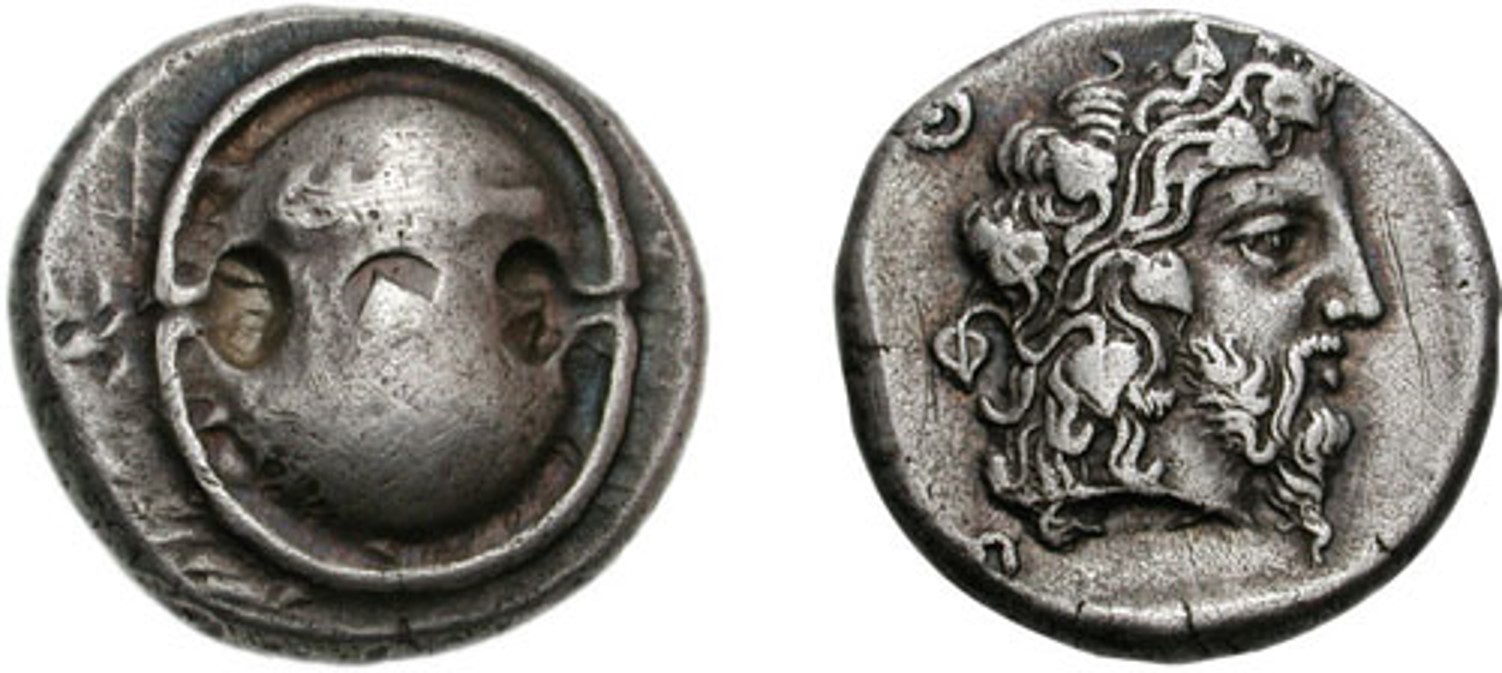SO 512 - Thebes over Elis
From SILVER
| Line 16: | Line 16: | ||
|Denomination=stater | |Denomination=stater | ||
|Standard=Aeginetic | |Standard=Aeginetic | ||
| − | |Coin reference=Babelon 1914, | + | |Coin reference=Babelon 1914, n° 241; HGC 4, n° 1325 |
| − | |Coin series reference=Babelon | + | |Coin series reference=Babelon 1901-1932, Tome 3, Part 2, n° 241; HGC 4, n° 1325 |
|Coin series web reference=https://greekcoinage.org/iris/id/thebes.babelon_1914.241 | |Coin series web reference=https://greekcoinage.org/iris/id/thebes.babelon_1914.241 | ||
|Overstruck obverse description=Eagle flying left. | |Overstruck obverse description=Eagle flying left. | ||
Latest revision as of 15:14, 16 May 2024
425 BCE - 395 BCE | Θ-E
Images
Overstriking coin

Thebes_shield_dionysos.jpg [1]
Location/history
| Sale(s)Sale(s) ᵖ: | Classical Numismatic Groupe, Triton IX, 10 Jan. 2006, 441 = Classical Numismatic Group, 108, 16 May 2018, 131 = Schweizerischer Bankverein, 38, 12 Sept. 1995, 156. | |
Overstriking coin
Description
| ObverseInscription or printing placed on the obverse.: | Boiotian shield ornamented with club. | ReverseInscription or printing placed on the reverse.: | Θ-E (Greek) Head of Dionysos right, wearing ivy wreath, within incuse square. |
Mint and issuing power
| MintIdentifies the place of manufacture or issue of a numismatic object.: | Thebes | Ancient regionAncient region. | Boeotia | Modern countryModern country: Greece | AuthorityIdentifies the issuing power. The authority can be "pretended" when the name or the portrait of X is on the coin but he/she was not the issuing power. It can also be "uncertain" when there is no mention of X on the coin but he/she was the issuing power according to the historical sources: |
Chronology
| FromIdentifies the initial date in a range assigned in a numismatic context. 425 BCE toIdentifies the final date in a range assigned in a numismatic context.. 395 BCE | Classical 480-323 BC |
Physical description
| MetalThe physical material (usually metal) from which an object is made.: Silver |
WeightWeight of the numismatic object (in grams). in grams: 12.1312.13 g <br />12,130 mg <br /> | DenominationTerm indicating the value of a numismatic object. Examples: tetradrachm, chalkous, denarius.: stater |
|
| StandardStandard.: Aeginetic | |||
References
| Coin referenceReference of the Coin: | Babelon 1914, n° 241, HGC 4, n° 1325 | Coin series referenceReference to coin series study: | Babelon 1901-19321Babelon 1901-1932, Tome 3, Part 2, n° 241, HGC 42HGC 4, n° 1325 |
| Coin series web referenceCoin series web references: | |||
Overstruck type
Description
| ObverseInscription or printing placed on the obverse.: | Eagle flying left. | ReverseInscription or printing placed on the reverse.: |
Mint and issuing power
| MintIdentifies the place of manufacture or issue of a numismatic object. ᵖ: | Elis | Ancient regionAncient region. ᵖ | Peloponnesus (Elis) | Modern countryModern country: Greece | AuthorityIdentifies the authority in whose name (explicitly or implicitly) a numismatic object was issued. ᵖ: |
Chronology
| FromIdentifies the initial date in a range assigned in a numismatic context. toIdentifies the final date in a range assigned in a numismatic context.. | Classical 480-323 BC |
Physical description
References
| Coin type referenceReference to coin series study ᵖ: |
Additional data
| Frequency of overstrikesFrequency of overstrikes: | frequent | Level of confidenceLevel of confidence of the identification: | |
| RemarksRemarks: | "Overstruck on a stater of Elis-Olympia with obverse type eagle flying left, animal in its talons. [...] This coin and lot 397 above may have been part of a consignment of Peloponnesian staters sent north during the war so that they could be converted to Boiotian currency to better serve the military plans of the Allies against Athens. The obverse dies of the undertype could only be Seltman, Temple, BD, BE or BG, all three of them belonging to the plentiful issues struck just before the beginning of the Peloponnesian war. " | ||
References
- ^ Babelon, Ernest (1901-1932), Traité des monnaies grecques et romaines, Paris, E. Leroux
- ^ Hoover, Oliver D. (2014), Handbook of Greek Coinage Series 4. Northern and Central Greece : Achaia Phthiotis, Ainis, Magnesia, Malis, Oita, Perrhaibia, Thessaly, Akarnania, Aitolia, Lokris, Phokis, Boiotia, Euboia, Attica, Megaris and Corinthia, sixth to first centuries BC, Lancaster, lxxi, 563 p.